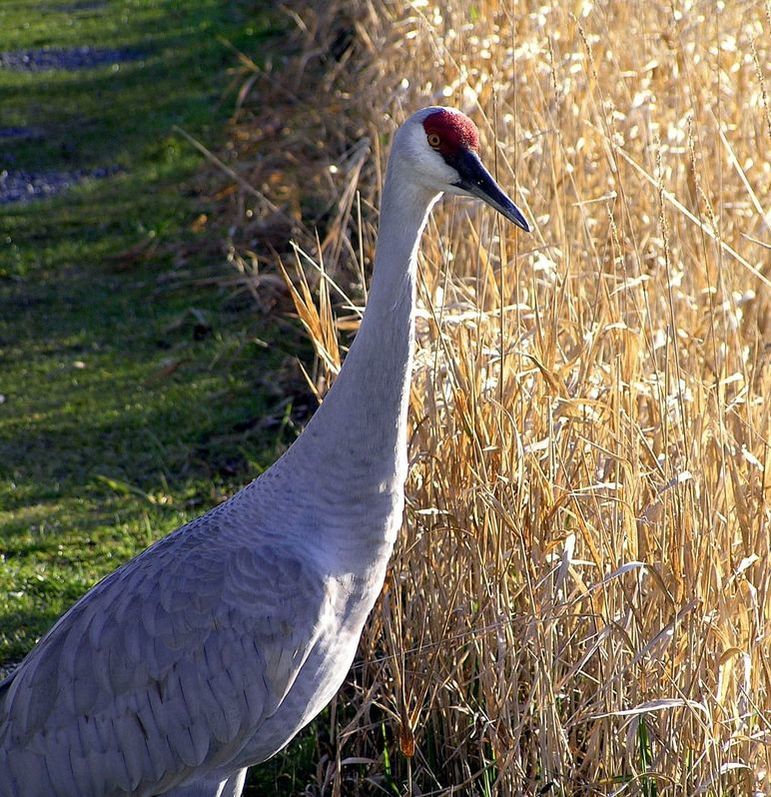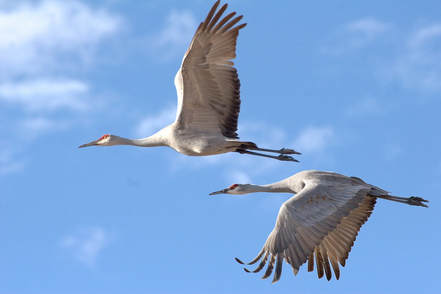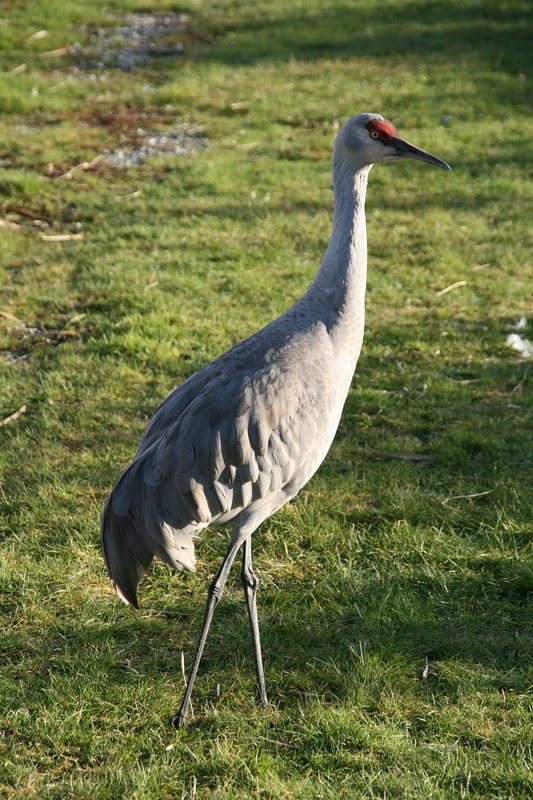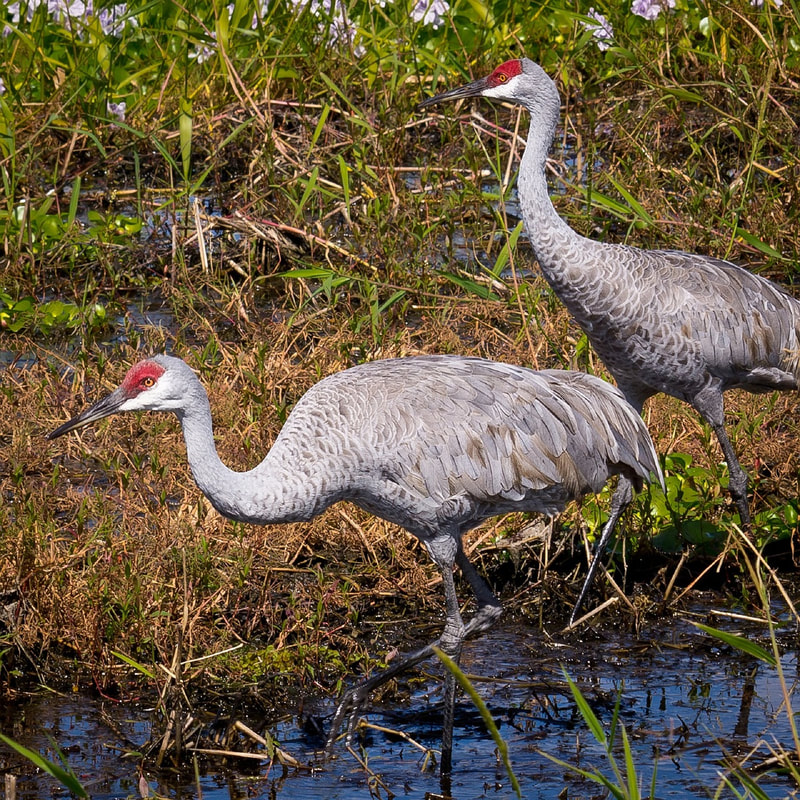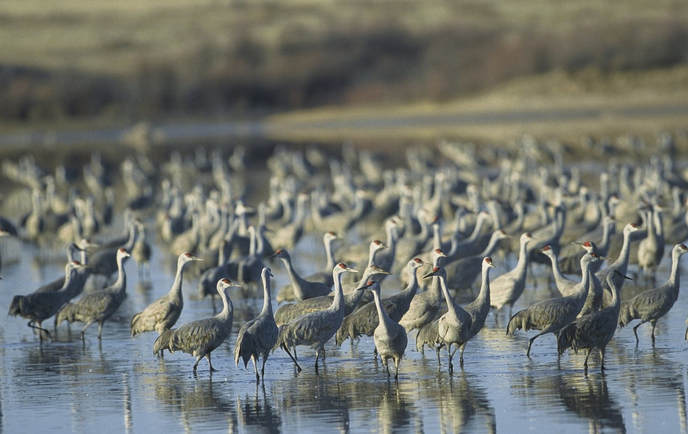Sandhill Cranes (Grus canadensis)
Sandhill Cranes are elegant and beautiful birds. There are three types/subpopulations of Sandhill Cranes that visit our valley - the Greater Sandhill Crane, the Lesser Sandhill Crane, and the Canadian Sandhill Crane. These three types are generally all lumped into one descriptor - Sandhill Crane. Coming from as far away as Alaska and Siberia, these guys make a long trek to visit us.
The Sandhill Crane arrival into the New Mexico Rio Grande River Valley is a sure sign that autumn has begun. Thousands of birds flock to this warmer winter sanctuary and will amass at places like the Bosque del Apache National Wildlife Refuge and other natural areas along the river corridor. New Mexico is a major migration route and a winter range for these cranes.
The Sandhill Crane arrival into the New Mexico Rio Grande River Valley is a sure sign that autumn has begun. Thousands of birds flock to this warmer winter sanctuary and will amass at places like the Bosque del Apache National Wildlife Refuge and other natural areas along the river corridor. New Mexico is a major migration route and a winter range for these cranes.
|
Physical Characteristics:
Sandhill Cranes are long legged, long necked, and heavy bodied birds. They can stand up to four feet tall, and can have a wingspan of up to seven feet wide. Weight for these birds can be up to 16 pounds. The adult males and females have no real distinguishable differences between them, unlike other birds. The adults all have a red/crimson skinned crown with gray feathers and a pale cheek. The juveniles, however, lack the red coloration and pale cheek and instead have a feathered crown, with gray and rusty-brown feathers, and a buff-coloration on their under wings. Both adult and juvenile alike have a thin, pointed black bill. When in flight, usually Cranes drag their black legs behind, and do not tuck them up like some other birds. However, you will sometimes see this happen in cold weather. |
|
Behavior & Habitat:
Sandhill Cranes are fairly social animals that will usually live and migrate in familial groups. During migration, it's not uncommon to see hundreds of cranes in one large flock. They often also fly very high in the sky which is unlike most other migratory birds. Sandhill Cranes like to spend their time in freshwater wetlands such as wet grasslands, river basins and marshes, but they are also known to like prairies and crop fields. They are actually opportunistic eaters but they most often eat plants and grains. The Cranes will forage for seeds, grains, nuts, berries, fruit, leaves, tubers, and other foods on surface land. (Most commonly they prefer corn, sorghum, and/or alfalfa fields, to the disgruntlement of some local farmers.) Cranes also eat invertebrate insects such as grasshoppers, sow bugs, worms, snails, and mollusks, so any loss of alfalfa plant roots is more than compensated for by the beneficial effect of their eating crop-damaging insects and invasive weed roots as well as their leaving of soil-enriching droppings. They will also snack on some small vertebrates like small reptiles, small fish, amphibians, etc., if that's what's available. The Cranes do not mate or breed during their visit to New Mexico. You'd need to go north in the spring to see those behaviors and mating dances. However, they bring their families with them during migration. Sandhill Cranes form pair bonds and they mate for life. This bond will last as long as the mates live. After one of them passes away, the surviving crane may, or may not, accept another mate. The lifespan of the Sandhill Cranes is generally around 20 years. The oldest known Crane thus far was 36 years and 7 months old! It was originally tagged in Wyoming in 1973, and was found in 2010 here in New Mexico. Neat! |
We accept donations to help feed the Cranes.
Keeping up with our feathered friends is a lot of work, and can be very expensive. If you would like to read more about what we do, and how we do it, check out our Caring for the Cranes webpage.
With weekly costs of about $400 to $500 in feed and seed blocks, the expense adds up quickly. We accept donations to help cover the costs associated with providing a safe sanctuary for these majestic birds. If you would like to contribute, we gratefully accept donations made through PayPal to the account [email protected]. Tell them it is a donation to help feed the cranes...or you can send a personal check through the mail to: Cranehaven B & B, 52 Adel Loop, Polvadera, NM 87828. Just mark it on your check as "donation for feeding and protecting Sandhill Cranes" We will make sure that is what every penny of your donation is spent on.
Thanks!
With weekly costs of about $400 to $500 in feed and seed blocks, the expense adds up quickly. We accept donations to help cover the costs associated with providing a safe sanctuary for these majestic birds. If you would like to contribute, we gratefully accept donations made through PayPal to the account [email protected]. Tell them it is a donation to help feed the cranes...or you can send a personal check through the mail to: Cranehaven B & B, 52 Adel Loop, Polvadera, NM 87828. Just mark it on your check as "donation for feeding and protecting Sandhill Cranes" We will make sure that is what every penny of your donation is spent on.
Thanks!
Donate to Help Feed the Cranes Fund for the Winter 2021 Crane Migration Season at Cranehaven Wild Bird Sanctuary
